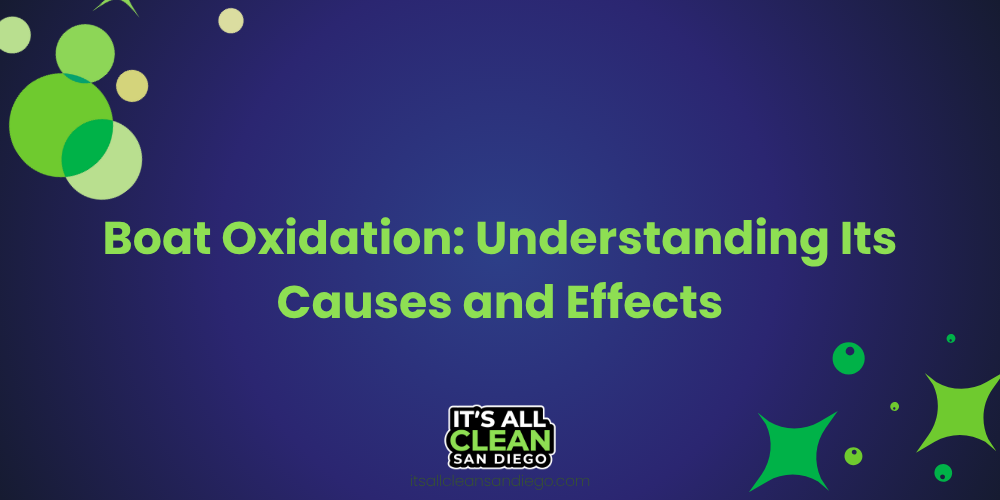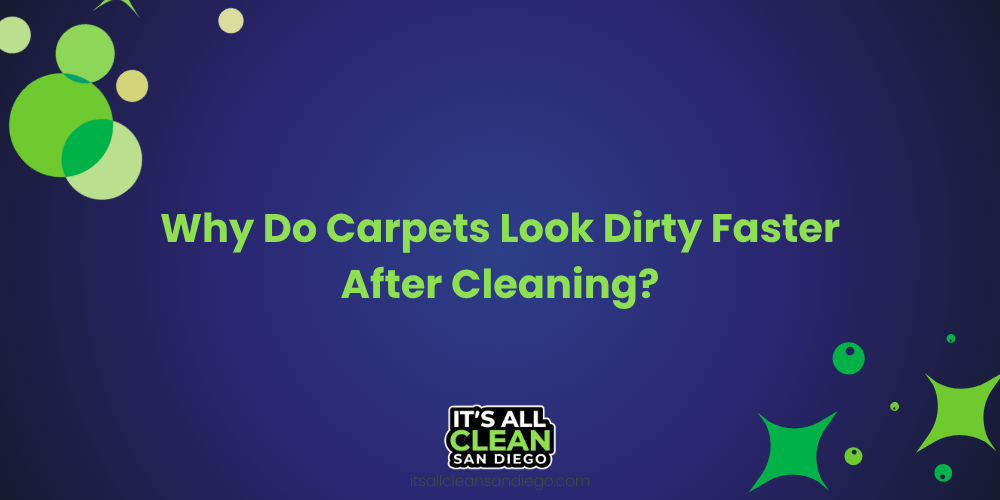San Diego, CA
If you’ve ever noticed your boat’s once-glossy finish turning dull, chalky, or faded, you’ve seen oxidation in action. It’s one of the most common and frustrating problems boat owners face—especially for those who love spending time on the water under the sun.
But oxidation isn’t just about looks. Left untreated, it can damage your boat’s gel coat, fiberglass, and resale value over time. To keep your vessel in pristine shape, it’s essential to understand what oxidation is, what causes it, and how it affects your boat’s surface and performance.

1. What Is Boat Oxidation?
Oxidation is a chemical reaction that occurs when oxygen molecules in the air interact with your boat’s surface materials—most commonly the gel coat (the smooth, protective outer layer on fiberglass boats) or painted metal surfaces on aluminum boats.
This reaction slowly breaks down the protective layers of your boat’s finish, causing fading, discoloration, and a rough, chalky texture. Essentially, oxidation is your boat’s version of rust, just in a different form.
The gel coat, which is meant to protect the fiberglass underneath, becomes porous as oxidation progresses—allowing UV rays, salt, and pollutants to cause deeper and more permanent damage.
2. The Main Causes of Boat Oxidation
Several environmental and maintenance-related factors contribute to oxidation, but the leading cause is prolonged exposure to UV light. Let’s look at the biggest culprits in more detail:
Sun and UV Exposure
Boats spend most of their time in direct sunlight, and UV rays are relentless. Over time, the sun’s radiation breaks down molecular bonds in the gel coat and paint, stripping away the oils and resins that keep surfaces glossy and sealed.
This is why you’ll notice oxidation first appearing on horizontal surfaces—like the deck or bow—where sunlight is most intense.
Saltwater and Airborne Moisture
Saltwater accelerates oxidation dramatically. When salt dries on your boat’s surface, it forms microscopic crystals that attract moisture and corrode the finish. Combined with sunlight and oxygen, salt acts like a catalyst that speeds up surface degradation.
Even boats kept near the coast are affected, since salt particles in the air cling to exposed surfaces.
Pollution and Acid Rain
Pollution from industrial and urban areas adds another layer of stress. Acid rain, smog, and airborne chemicals create acidic residues that can eat into the gel coat and increase oxidation.
Improper Cleaning and Maintenance
Many boat owners unintentionally make oxidation worse by using harsh detergents or abrasive cleaners that strip away wax or protective coatings. Without a UV-blocking layer, the gel coat is left defenseless against the elements.
Neglecting regular washing, waxing, and detailing allows dirt and salt to build up, trapping moisture and accelerating oxidation.
3. Stages of Boat Oxidation
Oxidation doesn’t happen overnight—it progresses in stages. Knowing what stage your boat is in helps you decide how to treat it effectively.
Stage 1: Early Oxidation (Fading and Dullness)
The boat’s color begins to fade, and the once-glossy surface starts to look flat or hazy. You might notice fine powdery residue (chalkiness) when you run your hand across the hull.
At this point, oxidation can usually be corrected with light polishing and a fresh coat of marine wax.
Stage 2: Moderate Oxidation (Chalky Surface)
The surface becomes noticeably chalky, and deeper color loss sets in. Dirt clings more easily to the hull, and water no longer beads up.
This level of oxidation requires machine polishing or compounding to remove the damaged outer layer before restoring shine and protection.
Stage 3: Severe Oxidation (Rough, Porous Surface)
At this stage, the gel coat is significantly compromised—rough, porous, and possibly showing signs of microcracking or yellowing.
Simple polishing won’t be enough. You’ll need aggressive compounding and multiple stages of correction, sometimes followed by gel coat restoration or refinishing.
If left untreated, oxidation can eventually expose the fiberglass underneath, leading to structural and cosmetic damage.
4. The Effects of Boat Oxidation
Beyond aesthetics, oxidation can cause a range of problems that affect your boat’s performance, durability, and value.
A. Cosmetic Degradation
The most visible sign of oxidation is a loss of color and shine. A once-vibrant hull becomes dull, chalky, and uneven. Not only does this ruin your boat’s appearance, but it also makes it harder to clean and maintain.
B. Surface Weakening
Oxidation erodes the smooth, sealed surface of your gel coat, making it porous and brittle. Over time, this allows water, salt, and pollutants to penetrate deeper—eventually compromising the fiberglass below.
C. Increased Drag and Reduced Efficiency
A rough, oxidized surface increases hydrodynamic drag, meaning your boat won’t glide through the water as efficiently. This can lead to higher fuel consumption and reduced speed performance.
D. Lower Resale Value
A faded, oxidized hull sends a strong signal to potential buyers that a boat hasn’t been properly maintained. Even minor oxidation can knock thousands off your resale price because it suggests deeper neglect or damage.
E. Long-Term Structural Damage
In advanced cases, oxidation can contribute to delamination, blistering, or cracks in the gel coat. Once moisture gets beneath the surface, it can lead to expensive repairs or full refinishing.
5. How to Prevent Boat Oxidation
The good news? Oxidation is completely preventable with proper care and consistent maintenance. Here’s how to stop it before it starts:
✅ Wash Regularly
Rinse your boat thoroughly after every outing—especially if you’ve been in saltwater. Use marine-safe soap to remove salt, grime, and pollutants that promote oxidation.
✅ Apply UV-Protective Wax or Sealant
After cleaning, apply a high-quality marine wax or ceramic coating formulated for fiberglass or gel coat surfaces. These products create a barrier that blocks UV rays, oxygen, and salt from penetrating the surface.
Reapply every few months (or more often for boats stored outdoors).
✅ Store Properly
If possible, store your boat under cover or use a UV-resistant boat cover. Keeping your vessel out of direct sunlight whenever it’s not in use dramatically slows oxidation.
✅ Avoid Harsh Chemicals
Skip household detergents, bleach, and abrasive cleaners. These strip away wax and accelerate oxidation. Always use marine-specific cleaning products that preserve your boat’s finish.
✅ Schedule Professional Detailing
Even with regular care, your boat benefits from periodic professional detailing. Professionals use advanced polishing, compounding, and sealing techniques to restore and protect your gel coat.
Companies like It’s All Clean San Diego use specialized tools and products designed to safely remove oxidation and apply durable, UV-blocking protection for long-term results.
6. Restoring an Oxidized Boat
If oxidation has already set in, don’t panic—restoration is possible. The process typically involves:
- Washing and Decontamination – Removing dirt, salt, and oxidation residue.
- Compounding – Using abrasive compounds and machine polishers to cut through the oxidized layer.
- Polishing – Refining the surface to restore gloss and smoothness.
- Waxing or Ceramic Coating – Applying a long-lasting protective barrier.
Severely oxidized boats may require multiple stages of compounding and polishing—or even gel coat refinishing for complete restoration.
7. Key Takeaway: Prevention Is Always Easier Than Restoration
Once oxidation starts, reversing it takes time, labor, and specialized equipment. Regular maintenance, on the other hand, is simple and far less expensive.
A consistent routine of washing, waxing, and protecting your boat is the best way to maintain its shine, performance, and value for years to come.
8. Keep Your Boat Shining with Professional Care
Boat ownership is an investment—one that deserves expert care. Whether your vessel needs oxidation removal, gel coat restoration, or just a professional detailing to bring back that mirror-like finish, It’s All Clean San Diego has you covered.
Our marine detailing specialists use professional-grade products and techniques to safely remove oxidation, restore color, and protect your boat against future damage. From bow to stern, we’ll make your boat look brand-new again.
Contact It’s All Clean San Diego today for a free quote and experience how professional marine detailing can protect your investment and keep your boat looking stunning all season long!
- All rights reserved -
It's All Clean San Diego © 2021
Pick a service, and we’ll be there.
Your go-to clean, green, full-service team.
Got a mess? We’ve got you covered. At It’s All Clean San Diego, we have professional commercial cleaning and residential house cleaning services for every need.
Our family-owned, full-service professional floor cleaning company has served residential and commercial customers in San Diego for nearly 20 years.










